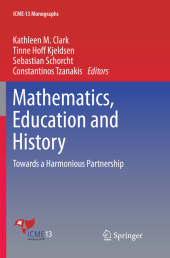 Neuerscheinungen 2019Stand: 2020-02-01 |
Schnellsuche
ISBN/Stichwort/Autor
|
Herderstraße 10
10625 Berlin
Tel.: 030 315 714 16
Fax 030 315 714 14
info@buchspektrum.de |

Kathleen M. Clark, Tinne Hoff Kjeldsen, Tinne Hoff Kjeldsen, Sebastian Schorcht, Constantinos Tzanakis
(Beteiligte)
Mathematics, Education and History
Towards a Harmonious Partnership
Herausgegeben von Clark, Kathleen M.; Hoff Kjeldsen, Tinne; Schorcht, Sebastian; Tzanakis, Constantinos
Softcover reprint of the original 1st ed. 2018. 2019. xii, 387 S. 125 SW-Abb. 235 mm
Verlag/Jahr: SPRINGER, BERLIN; SPRINGER INTERNATIONAL PUBLISHING 2019
ISBN: 3-03-008886-3 (3030088863)
Neue ISBN: 978-3-03-008886-6 (9783030088866)
Preis und Lieferzeit: Bitte klicken
This book includes 18 peer-reviewed papers from nine countries, originally presented in a shorter form at TSG 25 The Role of History of Mathematics in Mathematics Education, as part of ICME-13 during . It also features an introductory chapter, by its co-editors, on the structure and main points of the book with an outline of recent developments in exploring the role of history and epistemology in mathematics education. It serves as a valuable contribution in this domain, by making reports on recent developments in this field available to the international educational community, with a special focus on relevant research results since 2000.
The 18 chapters of the book are divided into five interrelated parts that underlie the central issues of research in this domain:
1. Theoretical and conceptual frameworks for integrating history and epistemology in mathematics in mathematics education;
2. Courses and didactical material: Design, implementation and evaluation;
3. Empirical investigations on implementing history and epistemology in mathematics education;
4. Original historical sources in teaching and learning of and about mathematics;
5. History and epistemology of mathematics: Interdisciplinary teaching and sociocultural aspects.
This book covers all levels of education, from primary school to tertiary education, with a particular focus on teacher education. Additionally, each chapter refers to and/or is based on empirical research, in order to support, illuminate, clarify and evaluate key issues, main questions, and conjectured theses raised by the authors or in the literature on the basis of historical-epistemological or didactical-cognitive arguments.
Introduction - K. M. Clark, T.H. Kjeldsen, S. Schorcht & C. Tzanakis
Part I - Theoretical and/or conceptual frameworks for integrating history and epistemology of mathematics in ME
I.1 : M. W. Johansen & T. H. Kjeldsen - The history of artefacts as a resource in mathematics education, and inquiry reflective learning environments
I.2 D. Guillemette - History of mathematics and teachers´ education: on otherness and empathy
I.3 I. Witzke, K. M. Clark, H. Struve & G. Stoffels - ÜBERPRO: addressing the transition from school to university: Initial results from a case study
Part II Courses and/or didactical material: Design, implementation and evaluation
II.1 K. Danielsen,, E. Gertz, & H. K S›rensen- Facilitating source-centered history of mathematics in Danish upper-secondary mathematics education
II.2 P. Baggett, & A. Ehrefeuc
ht - Involving students in original research with primary sources: A graduate course in the History of Mathematics Education
II.3 Y. Weiss-Pydstrygach & R. Kaenders - Algebra without context is empty, visualizations without concepts are blind
II.4 S. Schorcht - History of mathematics in German textbooks - typology of tasks
Part III - Empirical investigations on implementing history and epistemology in ME
III.1 I. Guevara-Casanova & C. Burgués-Flamarich - Geometry and visual reasoning to introduce algebraic language as Liu Hui and Al-Khwarizmi did
III.2 M.T. Sanz,. & B. Gómez - Missing curious fraction problems: the unknown inheritance and the unknown numbers of heirs
III.3 A. Bernardes & T. Roque - History of matrices: promoting commognitive conflicts and encouraging reflection on meta-discursive rules in prospective teachers
Part IV- Original
historical sources in teaching and learning of and about mathematics
IV.1 V. Tsiapou - Liu Hui shares his views with young students
IV.2 C. de Varent - Experimentation on the effects of mathematical diversity: Using ancient cuneiform mathematics on conceptual and nature of sciences aspects
IV.3 S. Spies I. Witzke - Making domain-specific beliefs explicit for prospective teachers - an example of using original sources
IV.4 J. Lodder - Primary historical sources in the classroom: Graph Theory and spanning trees
Part V - History and epistemology of mathematics: Interdisciplinary teaching and socio-cultural aspects
V.1 S. Schöneburg - The Pantograph - a historical drawing device for math teaching
V.2 P. Kotarinou, Ch. Stathopoulou & E. Gana - Expanding contexts for teaching upper secondary school geometry
V.3 S. Lawrence - Learning new
mathematics from old: Euclid´s art after Bath


